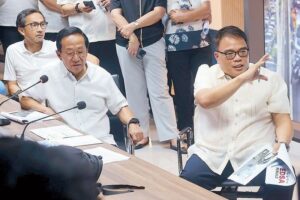MANILA, Philippines — The massive corruption scandal engulfing the Philippines’ Department of Public Works and Highways (DPWH) has intensified dramatically, with former Public Works Secretary Manuel Bonoan now implicated in a second “non-existent” flood control project in Bulacan province. The new findings, released just two days after he was first recommended for administrative charges, point to a pattern of negligence and deceit that allegedly led to the plunder of public funds.
The Independent Commission for Infrastructure (ICI), a fact-finding body established by President Marcos, presented its fourth interim report on Thursday, recommending an immediate investigation into Bonoan and two of his former undersecretaries, Roberto Bernardo and Maria Catalina Cabral. They face charges for violating the Code of Conduct and Ethical Standards for Public Officials over a P95.04 million project in Bocaue town.
This dual implication solidifies Bonoan’s position as the most senior former public official targeted by the ICI since the commission was established in September to probe the multibillion-peso corruption plague within the DPWH’s flood mitigation projects.
I. The Bocaue Boondoggle: P95 Million for Thin Air
The core of the latest accusation lies in the purported construction of a 147-meter concrete slope protection structure along a riverside in Barangay Bambang, Bocaue. The ICI report reveals that despite the full release and payment of the P95.04 million contract cost to the joint venture contractors, subsequent site inspections by the Commission on Audit (COA) confirmed a shocking truth: the project was never implemented.

The 19-page report, signed by ICI Chair and former Supreme Court Justice Andres Reyes, places the responsibility squarely at the top. The report alleges that the “ghost project” was facilitated by the “deliberate failure of the concerned public officials to fulfill their duties.”
“Were it not for the President’s 2025 SONA (State of the Nation Address), Secretary Bonoan’s inexcusable negligence tantamount to fraud would have resulted in further plunder of public funds,” the ICI report stated, underscoring the potential scale of the rot.
II. ‘Betrayal of Trust’: The Role of Command Responsibility
The ICI is recommending specific administrative charges of grave misconduct and gross dishonesty against Bonoan and his subordinates for their role in the unauthorized release of public funds. The Commission argued that as the DPWH Secretary, Bonoan “betrayed such trust reposed on him” by the public.
“He miserably failed to exercise simple diligence tantamount to fraud in ensuring the judicious use of public funds entrusted to DPWH,” the report emphasized. “As clearly shown by DPWH documents cited herein, the plunder of public funds happened right under his nose.”
Bonoan, who stepped down on August 31st, had previously acknowledged his “command responsibility” within the DPWH but has consistently and vehemently denied any personal involvement in corruption. Following an appearance at a House hearing on the controversial projects, he told reporters, “Absolutely, on my part, no, no, no, no!”—a denial that now stands in stark contrast to the ICI’s mounting evidence.
III. Fabricated Documents and the District Engineers
The scandal is not confined to the central office. The ICI also recommended a battery of criminal charges—graft, malversation, and falsification—for the Bocaue project against a total of eight engineers from the DPWH Bulacan first district District Engineering Office (DEO).
The implicated DEO officials include former District Engineer Henry Alcantara, former Assistant District Engineer Brice Hernandez, and several key personnel in planning, design, and maintenance roles. Similar criminal charges were recommended against Allan Payawal, who represented the two joint venture contractors, Topnotch Catalyst Builders Inc. and Beam Team Developer Specialist, Inc.
The evidence gathered points to a sophisticated scheme involving falsified documents:
Falsified Statements of Work Accomplished (SWAs): Bidding documents reportedly show “falsified” records indicating project “accomplishments” that were never achieved.
The Payment Trail: Payawal submitted three SWAs to the DPWH, which were purportedly examined by DPWH engineers and subsequently marked as “paid.” These SWAs falsely claimed progress: 51.5% accomplishment (April–July 2024), 89.7% accomplishment (July–Oct. 2024), and finally, a 100% completion claim (Oct. 2024–Jan. 2025).
Official Sign-Offs: Engineers John Carlo Rivera and Jaime Hernandez signed all three SWAs, while Alcantara and Brice Hernandez signed the first two, effectively certifying work that, according to COA, was non-existent.
The report sternly concluded that the approval of these SWAs by the DPWH Bulacan 1st DEO officials, despite the verified “non-existence of any work or construction at the identified location,” demonstrates either a gross failure to verify work or a knowing approval of a document that falsely certified compliance with the contract.
IV. Gaining Traction: The Double-Dipping Dilemma

This new P95.04 million charge follows closely on the heels of the ICI’s earlier finding on November 4th, where the Commission asked the Ombudsman to file graft, malversation, and falsification charges against Alcantara and Hernandez for a separate P72.4 million “ghost” flood control project in Plaridel, Bulacan. The repeated involvement of key local officials in multiple fraudulent projects suggests a deeply entrenched network of corruption.
Former Supreme Court Justice Reyes expressed guarded optimism about the progress of the investigation as the latest report was sent to the Ombudsman.
“We can escalate the findings against Bonoan and (others). But right now, this is the only evidence we have,” Reyes noted. “What is important is that the case is gaining traction already.”
The ICI’s relentless pursuit of these cases signals a strong, albeit challenging, commitment by the Marcos administration to root out deep-seated corruption that has plagued infrastructure projects for years. The alleged negligence of Bonoan, the highest authority at the time, has been cited as a major risk factor for “further plunder of public funds.”
The sheer audacity of paying out nearly P170 million (P95.04M + P72.4M) for projects that reportedly exist only on paper exposes a systemic breakdown in internal controls and auditing procedures within the DPWH. As the ICI continues its investigation, the nation awaits a swift and decisive action from the Ombudsman, hoping these revelations mark the beginning of true accountability in the handling of critical public funds intended for disaster preparedness.
